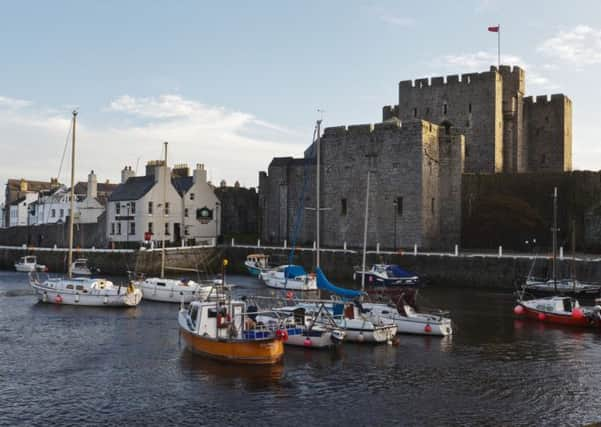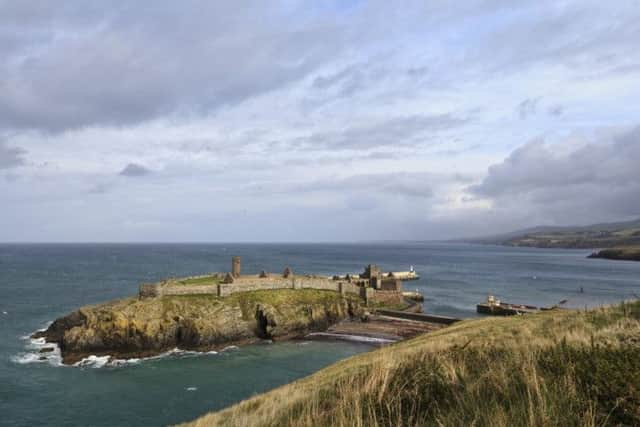Pocket Paradise


The man from the Isle of Man Steam Packet Company told me: “You have to pray to the god Manannan. He seems to be in charge of all the weather on the island.”
I’d half joked about praying for a smooth ferry crossing as I’m not the best of sailors. You see, I’d long wanted to visit Mann, enticed by pictures of Victorian tram cars snaking up Snaefell, fishing villages of pastel-painted cottages, beautiful bays and glens, and panoramic views from peaks. But to cross the Irish Sea in the worst weather the UK has seen for decades? It was going to take a miracle to calm my apprehension.
Advertisement
Hide AdAdvertisement
Hide AdAs things turn out, we arrive in Douglas, the capital, after an uneventful 3.5 hour crossing and get far more shaken rattling along on one of the ancient clacketty trams of the Manx Electric Railway.


We jump aboard at the northern end of Douglas’s 2.5mile-long promenade, our destination Snaefell, 2,036ft above sea level, and the highest point on the island. We switch at Laxey for the mountain railway. As we climb higher, the conductor points out south-east Scotland, the Solway Firth and part of Anglesey. On a clearer day we’d be able to see the Mountains of Mourne in Northern Ireland.
It’s so blustery when we get out that we struggle to stand upright. Daughter Sophie and I cling tightly to the trig point which marks the summit. Spread before us is what the conductor calls “Seven Kingdoms”. Five are obvious; England, Ireland, Wales, Scotland and the island itself. The other two – the kingdoms of heaven and the sea.
Another big pull of Mann is that many of the island’s must-sees are accessible by tram or train. Sadly as we’ve come at the tail end of the season, the famous horse-drawn trams on Douglas seafront aren’t running. But Lady Isabella is and she more than makes up for it. Close up, she’s a graceful beauty; the world’s largest working waterwheel, named after the wife of the governor who commissioned the Great Laxey Wheel.
Advertisement
Hide AdAdvertisement
Hide AdA spiral staircase leads us to the 72ft high platform. The views of Laxey, the harbour and surrounding countryside have been drawing tourists here for 160 years. We’re close enough to feel the spray as her 192 buckets revolve, mindful that when the north wind blows the wheel stalls. It’s dark by the time we get on the last tram to Douglas. We seem to fly down the track. There are no fewer than 60 halts along the line.
Our steam railway journey to Castletown and Port Erin is far more sedate. It’s the longest narrow gauge steam line in Britain, opened in 1874. We’re immediately reminded of Ireland as we get out at Castletown. Castle Rushen, which presides over the town, has been a royal residence, a mint, prison and asylum in its time. It’s magnificent and a tiny bit spooky.
The Nautical Museum is an absolute curiosity. We’ve come to see The Peggy (circa 1790), the world’s oldest yacht which was found walled in here in 1935. We’re also intrigued by a room styled like a cabin from Nelson’s day. Sophie is fascinated by disguised cupboards opened by hidden catches and a concealed passageway where locker drawers become a staircase.
A visit to the Chasms, near the southern tip of the island, should be exhilarating but is a rather unnerving one. The gorse overgrows deep and narrow fissures, making the gaps very hard to see. When I feel confident enough to raise my head, I’m stunned by the sea views with the large conical stack of rock that they call the Sugar Loaf in the foreground.
Advertisement
Hide AdAdvertisement
Hide AdThe rest of that day is a dream. Earlier we’d parked by the Sound Visitor Centre at the tip of the Meayll peninsular, opposite the Calf of Man, a nature reserve. It was barely a minute before we spotted the first of several seals.
We had planned to spend all afternoon at Cregneash, a folk museum village. Then the guide who greeted us in period costume began to tell us about some lovely walks and that was it, we were off.
On Meayll Hill, above the village, Sophie performs cartwheels on top of what’s left of a World War II radar station. Port Erin, with its landmark Milner’s Tower, lies ahead of me. Directly below me is the Neolithic Meayll Stone Circle (3,500BC). To my right, Port Mary with its multitude of boats and, beyond, Castletown. I turn and there’s the Calf of Man under the setting sun.
It brings to mind an old poster I’d seen in the Manx Museum in Douglas. It read: “Nowhere too remote or too isolated for a day trip. The pocket paradise of the British Isles”.
Getting there
Advertisement
Hide AdAdvertisement
Hide AdThe Isle of Man Steam Packet Company offers a number of routes to Douglas. For offers visit www.steam-packet.com/Offers/Cars or call 08722 992 992.
The Manx Museum, Douglas; One of the best museums we’ve visited (free). Walk through time and the island’s history, from Vikings and the medieval age to the TT. Also houses the National Art Gallery.
Cregneash; picturesque village with thatched Manx cottages open to explore, plus Loghtan sheep, Shorthorn cows, working horses and craft demonstrations.
Peel Castle; Legend has it that St Patrick visited here, bringing Christianity to the Isle of Man.
Advertisement
Hide AdAdvertisement
Hide Ad* Old House of Keys, Castletown; join in a lively debate in the former home of the Manx Parliament. Animated portraits of Keys members and a simulated model of Mr Speaker bring the debating chamber to life.
*For information on the above visit www.manxnationalheritage.im